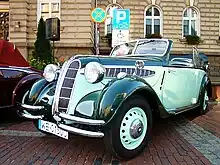BMW 321
The BMW 321 is a compact six-cylinder automobile produced by the Bavarian firm between 1938 and 1941. After 1945, production of the 321 resumed at the Eisenach plant and continued until 1950.
| BMW 321 | |
|---|---|
 BMW 321 2-door saloon | |
| Overview | |
| Manufacturer | Bayerische Motoren Werke AG (BMW) Sowjetische AG Maschinenbau Awtowelo |
| Production | 1938–1941, 3,814 built[1] 1945 - 1950, 8,996 built[2] |
| Body and chassis | |
| Class | Mid-size car |
| Body style | 2-door saloon 2-door cabriolet[3] |
| Layout | FR layout |
| Related | BMW 326 BMW 320 BMW 340 |
| Powertrain | |
| Engine | 1,971 cc (120.3 cu in) M78 I6 |
| Transmission | 4-speed manual[4] |
| Dimensions | |
| Wheelbase | 2,750 mm (108 in)[4] |
| Length | 4,500 mm (180 in) |
| Width | 1,540 mm (61 in) |
| Height | 1,500 mm (59 in) |
| Curb weight | 1,000 kg (2,200 lb) (measurements approximate)[3] |
| Chronology | |
| Predecessor | BMW 320 |
| Successor | BMW New Class |
The launch
The 321 was introduced at the start of 1939 as a successor to the BMW 320.[5] It sat on a shortened version of the BMW 326 chassis. The 321 differed from the 320 in its front suspension, its larger tyres, and its styling. While the 320 used front suspension derived from the BMW 303, with a high mounted transverse leaf spring and lower control arms, the 321 used the front suspension from the 326, with upper control arms and a low mounted transverse leaf spring.[1]
Body options
The car was available both as a two-door sedan and as a two-door cabriolet.[1][3] In addition, BMW offered a chassis-only option suitable for a coach-built body.[5]
Engine and transmission
The 1971 cc straight 6 M78 engine was based on the engine in the BMW 326 with a claimed power output of 45 PS (33 kW; 44 hp) and maximum speed of 115 km/h (71 mph).[3] The four-speed manual gear box was also the one already seen on the 326.
Commercial
Two years after the introduction of the 321, in 1941, automobile production at the Eisenach plant was suspended in favour of war production. By then, 3,814 had been built.[1]
Production after World War II


In 1945, Eisenach was occupied by American forces, but by then it had already been agreed between the allies that the whole of Thuringia would fall within the Soviet occupation zone: transfer of the region to the Soviets took place in July 1945. It seemed likely that BMW's manufacturing facility would be crated up and taken by rail to the Soviet Union as part of the substantial post war reparations package. In the meantime, surviving workers returning from the war recommenced automobile production, on a very small scale, using prewar designs. Albert Seidler, the man in charge of Eisenach motor bike production, demonstrated the 321 to Marshal Zhukov and secured from him an order for five new cars. The Russians were evidently impressed, and the plant passed under the control of “Sowjetische AG Maschinenbau Awtowelo”, a Soviet directed holding company focused on vehicle production. A further 8,996 BMW 321s are thought to have been built between 1945 and 1950. Most appear to have remained to the east of the Iron Curtain, many being taken to the Soviet Union as part of a reparations package in respect of the Second World War. Evidence also exists for exports to the west: the car was advertised in Switzerland in 1949 with a retail price of CHF 10,300.[6]
References
- Norbye, Jan P. (1984). BMW - Bavaria's Driving Machines. Skokie, IL USA: Publications International. p. 70. ISBN 0-517-42464-9.
- Robson, Graham (2008-11-07). "Chapter 5: Losing Eisenach, Building Up Munich". Inside the BMW Factories: Building the Ultimate Driving Machine. Minneapolis, MN US: MBI Publishing. p 58, EMW—Like BMW? The Same, but Different. ISBN 978-0-7603-3463-8. Retrieved 2013-02-16.
- For saloon: "BMW 321 Limousine" [BMW 321 Limousine]. BMW Group Archive (in German). Archived from the original on 2013-01-25. Retrieved 2013-02-15.
For cabriolet: "BMW 321 Kabriolett" [BMW 321 Cabriolet]. BMW Group Archive (in German). Archived from the original on 2013-01-25. Retrieved 2013-02-15. - "1939 BMW 321 Saloon". Archived from the original on 2011-11-14. Retrieved 15 February 2013.
- Odin, L.C. World in Motion 1939 - The whole of the year's automobile production. Belvedere Publishing, 2015. ASIN: B00ZLN91ZG.
- Gloor, Roger (2007). Alle Autos der 50er Jahre 1945 - 1960 1. Auflage. Stuttgart: Motorbuch Verlag. ISBN 978-3-613-02808-1.